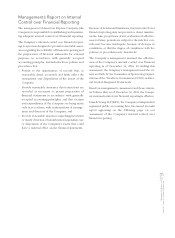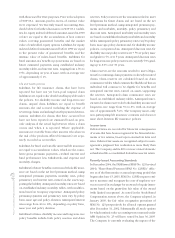American Express 2004 Annual Report Download - page 87
Download and view the complete annual report
Please find page 87 of the 2004 American Express annual report below. You can navigate through the pages in the report by either clicking on the pages listed below, or by using the keyword search tool below to find specific information within the annual report.
under APB Opinion No. 25. The following table illustrates
the effect on net income and earnings per common share
(EPS) assuming the Company had followed the fair
value recognition provisions of SFAS No. 123 for all
outstanding and unvested stock options and other stock-
based compensation for the years ended December 31,
2004, 2003 and 2002:
(Millions, except per share amounts) 2004 2003 2002
Net income as reported $ 3,445 $ 2,987 $ 2,671
Add: Stock-based employee compensation expense included
in reported net income, net of related tax effects 141 79 26
Deduct: Total stock-based employee compensation expense
determined under fair value based method, net of related
tax effects (325) (349) (355)
Pro forma net income $ 3,261 $ 2,717 $ 2,342
Basic EPS:
As reported $ 2.74 $ 2.33 $ 2.02
Pro forma $ 2.59 $ 2.12 $ 1.77
Diluted EPS:
As reported $ 2.68 $ 2.30 $ 2.01
Pro forma $ 2.54 $ 2.09 $ 1.76
Marketing, promotion, rewards and cardmember services
The Company expenses advertising costs in the year in
which the advertising first takes place.
The Company’s Membership Rewards program allows
enrolled cardmembers to earn points that can be
redeemed for a broad range of rewards including travel,
entertainment, retail certificates and merchandise. The
Company establishes reserves to cover the cost of future
reward redemptions and typically makes payments to its
reward partners when cardmembers redeem their points.
The reserve for Membership Rewards is estimated using
models that analyze redemption statistics and also reflect,
to a lesser extent, management’s judgment regarding
overall adequacy. The ultimate points to be redeemed by
cardmembers are estimated based on many factors
including past redemption behavior of cardmembers,
product type, year of enrollment, spend level and dura-
tion in the program. Past behavior is used to predict when
current enrollees will leave the program and their ulti-
mate redemption rate.
The provision for the cost of Membership Rewards is
based upon points earned that are ultimately expected
to be redeemed by cardmembers and the current
weighted-average cost per point of redemption. The
weighted-average cost per point is affected by the mix
of rewards redeemed. The provision and related bal-
ance sheet reserve for unredeemed points are
impacted over time based on a number of factors
including changes in the number of cardmembers in
the Membership Rewards program, the actual amount
of points earned and redeemed, the actual weighted-
average cost per point, the availability of Membership
Rewards offerings by vendors, the redemption choices
made by cardmembers and future changes the Com-
pany could make to the program.
Balance Sheet
Cash and cash equivalents
The Company has defined cash equivalents to include
time deposits and other highly liquid investments with
original maturities of 90 days or less. At December 31,
2004 and 2003, cash and cash equivalents included
$1.0 billion and $1.1 billion, respectively, segregated in
special bank accounts for the benefit of customers. The
Company classified restricted cash totaling $1.1 billion
and $1.3 billion at December 31, 2004 and 2003, respec-
tively, in other assets in cases where cash cannot be
utilized for operations.
Investments
Available-for-Sale investment securities are carried at
fair value on the balance sheet with unrealized gains
(losses) recorded in equity, net of income tax provi-
sions (benefits). Gains and losses are recognized in
results of operations upon disposition of the securities.
In addition, losses are also recognized when manage-
ment determines that a decline in value is other-than-
temporary, which requires judgment regarding the
amount and timing of recovery. Indicators of other-
than-temporary impairment for debt securities include
issuer downgrade, default or bankruptcy. The Com-
pany also considers the extent to which cost exceeds
fair value, the duration and size of that gap, and
management’s judgment about the issuer’s current and
prospective financial condition. Fair value is gener-
ally based on quoted market prices. However, the
AXP
AR.04
85
Notes to Consolidated Financial Statements
























